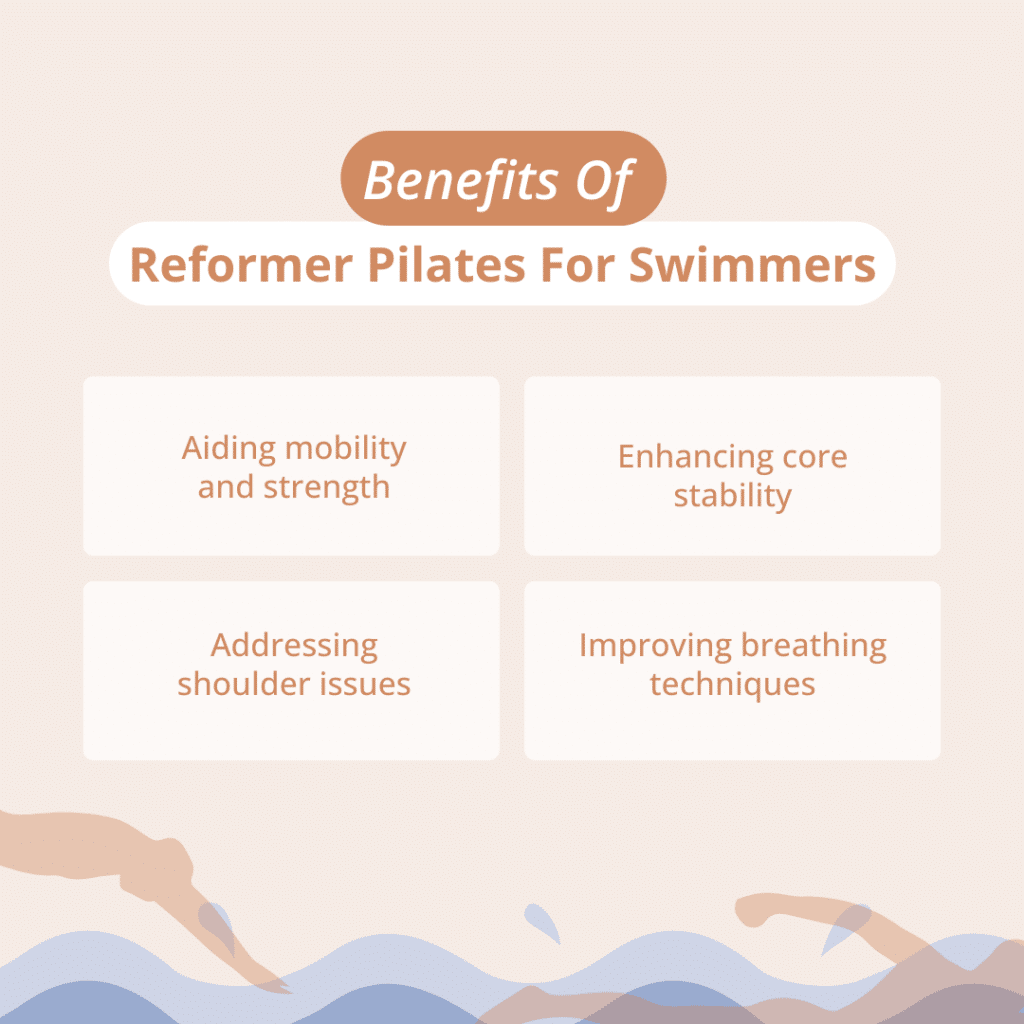As a swimmer, you’ll know the exhilarating feeling of slicing through the water and gliding up to the surface to start your stroke. You’re probably also familiar with the toll it can take on your body… especially your upper body! That’s where reformer Pilates comes in – offering a tailored approach to release built-up muscle tension and support your overall wellness. Let’s dive (no pun intended) into how Pilates can be a game-changer for swimmers, targeting common injuries and complaints to enhance strength, mobility and overall performance.

Aiding Mobility and Strength
Swimming isn’t just about being fast – it’s about moving better and feeling stronger, both in and out of the water. It also requires you to work on your mobility so that you can nail those strokes and maintain your power lap after lap.
Using reformer Pilates as an additional exercise within your swim training is an amazing way to support and strengthen your muscles and joints with precision. It’s all about elongating your muscles and releasing tension, so you can reach further with every stroke. Exercises like arm circles, shoulder bridges and leg circles help to elongate muscles, improve joint mobility, and enhance overall flexibility, ensuring you can move more efficiently in the water.
Enhancing Core Stability
A strong core is essential for you to maintain proper body alignment in the water and generate power in your stroke. Pilates focuses on strengthening the deep core muscles, including the abdominals, obliques and back muscles, which are crucial for stability and control in the water.
Movements such as the hundred, planks and v-sit ups specifically target the core, helping you and all swimmers to develop a solid foundation for improved performance and injury prevention. By focusing on these muscles, Reformer Pilates helps swimmers develop a strong and resilient core that can withstand the demands of swimming strokes.
Core Activation Techniques
For swimmers aiming to enhance their upper body strength and core activation, incorporating pilates exercises can be particularly beneficial. These exercises focus on precise body alignment and controlled movements, which are essential for optimising performance in the pool.
Engaging in core exercises like the pilates roll-up and leg stretches (like the double leg stretch) not only builds core strength but also ensures that every stroke is powerfully supported by a robust upper body. This integration of core activation and strength training ensures that swimmers not only increase their power, efficiency and core control, but also minimise the risk of injuries associated with repetitive swimming motions.
Addressing Shoulder Issues
Shoulder injuries are all too common among swimmers, often stemming from the repetitive overhead movements involved in strokes like freestyle, butterfly, and backstroke. These movements can lead to muscle imbalances, tendonitis, and even more severe conditions like rotator cuff injuries. That’s where Pilates comes in as a game-changer for swimmers seeking to protect their shoulder blades and keep their shoulders in top form.
Pilates offers a targeted approach to shoulder health, focusing on strengthening the muscles surrounding the shoulder joint while improving flexibility and range of motion. Specific exercises like arm circles, shoulder bridges, and scapular stabilisation movements help to build strength and stability in the rotator cuff muscles, enhancing joint integrity and reducing the risk of injury.
Improving Breathing Technique
If you’re spending half of your life underwater, it’s definitely a good idea to make sure that you’re using your breath correctly and efficiently. This is also important to maintain rhythm and pace whilst your in the water. Similarly to yoga, Pilates incorporates breathing techniques throughout the class to ensure that clients provide their muscles with oxygen and therefore, energy. Without this important practice, those doing Pilates would experience fatigue much quicker.
With this in mind, swimmers would greatly benefit from Pilates to synchronise their breath with movement for greater efficiency and control. Exercises like the chest expansion, thoracic rotation, and Rib Cage Expansion help swimmers develop a deeper connection to their breath, enhancing endurance, improving their swimming technique and boosting performance in the pool.
Experience The Benefits Of Pilates For Swimmers
Incorporating Pilates into a swimmer’s training routine can provide a number of benefits, from increased flexibility and strength to improved posture and injury prevention. By targeting specific areas of concern and promoting overall body awareness, Pilates offers swimmers a holistic approach to enhancing their performance in the water. So, whether you’re a competitive swimmer or a casual enthusiast, consider adding Pilates to your routine to take your swimming game to the next level.
Join the Muse Pilates Movement
Looking to kickstart your wellness journey with Reformer Pilates? Sign up for our exclusive Intro Offer for just $49 here!

